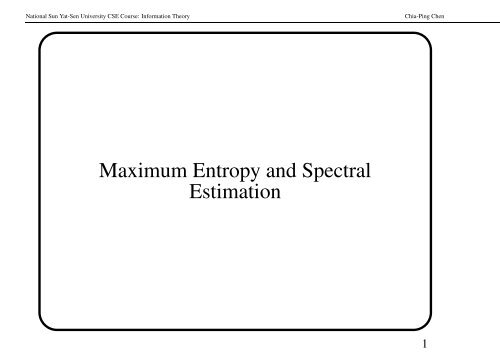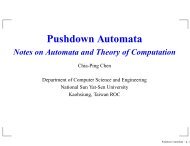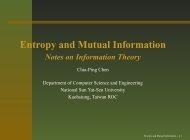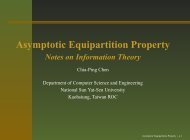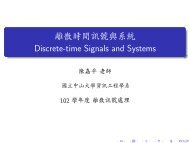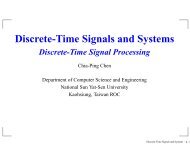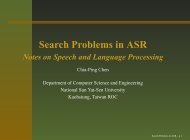Maximum Entropy and Spectral Estimation
Maximum Entropy and Spectral Estimation
Maximum Entropy and Spectral Estimation
Create successful ePaper yourself
Turn your PDF publications into a flip-book with our unique Google optimized e-Paper software.
National Sun Yat-Sen University CSE Course: Information Theory<br />
Chia-Ping Chen<br />
<strong>Maximum</strong> <strong>Entropy</strong> <strong>and</strong> <strong>Spectral</strong><br />
<strong>Estimation</strong><br />
1
National Sun Yat-Sen University CSE Course: Information Theory<br />
Chia-Ping Chen<br />
Introduction<br />
• What is the distribution of velocities in the gas at a given<br />
temperature It is the Maxwell-Boltzmann distribution.<br />
• The maximum entropy distribution corresponds to the<br />
macrostate with the maximum number of microstates.<br />
• Implicitly assumed is that all microstates are equally<br />
probable, which is an AEP property.<br />
2
National Sun Yat-Sen University CSE Course: Information Theory<br />
Chia-Ping Chen<br />
<strong>Maximum</strong> <strong>Entropy</strong> Problem <strong>and</strong> Solution<br />
• Problem: Find a distribution f ∗ (x) with maximal<br />
entropy h(f) over the set of functions satisfying the<br />
following constraints.<br />
– f(x) ≥ 0.<br />
– ∫ f(x)dx = 1.<br />
– E(r i (X)) = ∫ f(x)r i (x)dx = α i , for i = 1, . . . , m.<br />
• Solution:<br />
f ∗ (x) = e λ 0+ P m<br />
i=1 λ ir i (x) .<br />
3
National Sun Yat-Sen University CSE Course: Information Theory<br />
Chia-Ping Chen<br />
• Proof: For any g(x) satisfying the constraints,<br />
∫<br />
∫<br />
h(g) = − g(x) log g(x)dx = − g log g f f ∗ dx<br />
∫<br />
∗<br />
= −D(g||f ∗ ) − g(x) log f ∗ (x)dx<br />
∫<br />
≤ − g(x) log f ∗ (x)dx<br />
∫<br />
m∑<br />
= − g(x)(λ 0 + λ i r i (x))dx<br />
∫<br />
= −<br />
= h(f ∗ )<br />
f ∗ (x)(λ 0 +<br />
i=1<br />
m∑<br />
λ i r i (x))dx<br />
i=1<br />
4
National Sun Yat-Sen University CSE Course: Information Theory<br />
Chia-Ping Chen<br />
Examples<br />
• r i (x) is the exponent in the exponential. λ i is determined<br />
by the constraints.<br />
• Examples<br />
– Dice, no constraints: p(i) = const<br />
– Dice, EX = α: p(i) ∝ e λi<br />
– S = [0, ∞), EX = µ: f(x) ∝ e λx<br />
– S = (−∞, ∞), EX = µ, EX 2 = β: Gaussian<br />
N(µ, β − µ 2 ) ∝ e λ 1x+λ 2 x 2<br />
– Multivariate EX i X j = K ij , 1 ≤ i, j ≤ n:<br />
f(x) ∝ e P i,j λ ijx i x j<br />
(Theorem 9.6.5)<br />
5
National Sun Yat-Sen University CSE Course: Information Theory<br />
Chia-Ping Chen<br />
<strong>Spectral</strong> <strong>Estimation</strong><br />
• Let {X i } be a zero-mean stochastic process.<br />
• The autocorrelation function is defined by<br />
R[k] = EX i X i+k<br />
• The power spectral density is the Fourier transform of<br />
R[k]<br />
S(λ) = ∑ k<br />
R[k]e −iλk , −π ≤ λ ≤ π<br />
• So we can estimate the spectral density from a sample of<br />
the process.<br />
6
National Sun Yat-Sen University CSE Course: Information Theory<br />
Chia-Ping Chen<br />
Differential <strong>Entropy</strong> Rates<br />
• The differential entropy rate of a stochastic process is<br />
defined by<br />
if the limit exists.<br />
h(X 1 , . . . , X n )<br />
h(X) = lim<br />
,<br />
n→∞ n<br />
• For a stationary process, the limit exists. Furthermore,<br />
h(X) = lim<br />
n→∞<br />
h(X n |X n−1 , . . . , X 1 )<br />
7
National Sun Yat-Sen University CSE Course: Information Theory<br />
Chia-Ping Chen<br />
Gaussian Processes<br />
• A Gaussian process is characterized by the property that<br />
any collection of r<strong>and</strong>om variables in the process is<br />
jointly Gaussian.<br />
• For a stationary Gaussian process, we have<br />
h(X 1 , . . . , X n ) = 1 2 log(2πe)n |K (n) |,<br />
where K (n) is the covariance matrix for (X 1 , . . . , X n ).<br />
K (n)<br />
ij = E(X i − EX i )(X j − EX j )<br />
• As n → ∞, the density of eigenvalues of K (n) tends to a<br />
limit, which is the spectrum of the stochastic process.<br />
8
National Sun Yat-Sen University CSE Course: Information Theory<br />
Chia-Ping Chen<br />
<strong>Entropy</strong> Rate <strong>and</strong> Variance<br />
• Kolmogorov showed that the entropy rate of a stationary<br />
Gaussian process is related to the spectral density by<br />
(11.39).<br />
• So the entropy rate can be computed from the spectral<br />
density.<br />
• Furthermore, the best estimate of X n given the past<br />
samples (which is Gaussian) has a variance that is related<br />
to the entropy rate by (11.40).<br />
9
National Sun Yat-Sen University CSE Course: Information Theory<br />
Chia-Ping Chen<br />
Burg’s <strong>Maximum</strong> <strong>Entropy</strong> Theorem<br />
• The maximum entropy rate stochastic process {X i }<br />
satisfying the constraints<br />
EX i X i+k = α k , k = 0, . . . , p<br />
is the p-th order Gauss-Markov process<br />
X i = −<br />
p∑<br />
k=1<br />
a k X i−k + Z i ,<br />
where the Z ′ is are i.i.d. zero-mean Gaussians N(0, σ 2 ).<br />
The a i ’s <strong>and</strong> σ are chosen to satisfy the constraints.<br />
• See the text for the proof.<br />
10
National Sun Yat-Sen University CSE Course: Information Theory<br />
Chia-Ping Chen<br />
Yule-Walker Equations<br />
• To choose a k <strong>and</strong> σ, one solves the Yule-Walker<br />
equations as given in (11.51) <strong>and</strong> (11.52), which are<br />
obtained by multiplying (11.42) by X i−l , l = 0, 1, . . . , p<br />
<strong>and</strong> taking expectation values.<br />
• The Yule-Walker equations can be solved efficiently by<br />
the Levinson-Durbin recursions.<br />
• The spectrum of the maximum entropy process is<br />
S(l) =<br />
σ 2<br />
|1 + ∑ a k e −ikl | 2 ,<br />
which can be obtained from (11.51).<br />
11


